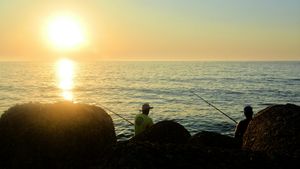The idyllic Greek island of Santorini has been thrust onto the global stage, not for its breathtaking sunsets or stunning architecture, but for the severe seismic activity shaking its foundations. The Greek government has declared a state of emergency on the island due to relentless underwater earthquakes, with the strongest tremor recently registering at a magnitude of 5.2. This seismic turmoil has not only unsettled the land but alarmed its residents and tourists alike.
The state of emergency, which has been backdated to February 1 and will remain effective until March 3, aims to facilitate swift emergency responses amid growing fears of landslides and falling rocks. Since January 26, the earthquake tally has skyrocketed, exceeding 7,700 tremors within just nine days; this unsettling pattern of activity has raised significant concerns among both residents and experts.
Officials are not taking these earthquakes lightly. Iakovos Poussos, the Mayor of Anafi, pointed out the psychological toll on the residents: "These continuous tremors are starting to tire us, especially last night. It just kept going." The sentiment is echoed across the island as countless individuals feel the weight of the ceaseless shaking. ERT reported residents expressing their fatigue, saying, "There are people who are just tired of these quakes every two minutes. They can’t rest or sleep at night."
Despite the unrest, the emergency declaration allows local authorities to bypass bureaucratic red tape, enabling them to mobilize resources and support more rapidly. Emergency services, including police and fire departments, have been augmented by military forces, who are preparing field kitchens to provide meals for both residents and rescue workers. These efforts are part of broader precautions to support the approximately 15,000 inhabitants left on the island, many of whom have already fled to the Greek mainland.
Notably, the evacuation of residents and tourists has been substantial, with estimates indicating around 11,000 of the 16,000 citizens have already left. The tourism sector, which attracts visitors for its iconic views and rich history, is now grappling with uncertainty. Local businesses reliant on tourism have seen declines as travelers reconsider their plans. The local economy's reliance on such visitation can’t be understated, but safety remains the priority.
Authorities have acted decisively, closing schools across Santorini and nearby islands, such as Anafi, Paros, Naxos, and Mykonos, to protect students during this unpredictable phase. Schools are expected to remain closed until the seismic activity stabilizes. Only time will tell how long this precarious situation will endure.
Adding to the urgency of the situation, the Geodynamics Institute in Athens commented, "This was the strongest shock since the beginning of the current series of earthquakes." Seismologists and geologists have painted varying scenarios for the potential evolution of these quakes. A major aftershock could lead to temporary stability, but there's also the risk of continuous agitation for weeks or even months. The worst-case scenario—a severe quake of magnitude seven or higher—could lead to widespread destruction and loss of life, reminiscent of past disasters linked to volcanic activity.
One significant concern raised by experts is the effect of earthquakes on the volcanic structures surrounding Santorini. Bruno Tersago, reporting for various outlets, stated, "The earthquakes could awaken the various volcanoes in the region, leading to even more problems for the island." This looming threat echoes the catastrophic volcanic eruption of 1650, when the undersea Kolumbo volcano exploded, resulting in tsunamis and fatalities.
Authorities are currently assessing public buildings and other infrastructure, and precautions are being implemented to protect against potential landslides and falling rocks. There are limitations on public access to areas identified as high-risk zones, reflecting the seriousness of the government's response to the crisis.
With seismic activity still prevalent, the fate of Santorini hangs by a thread. Will the island weather this storm of geological upheaval and emerge unchanged, or will its charming landscapes be irrevocably altered? Residents and officials alike tread cautiously, hoping for the latter.
The situation’s progression remains closely monitored, and local authorities continue to adapt to the challenges brought forth by this natural disturbance. Santorini’s global significance as both a residential community and vibrant tourism destination depends on the effectiveness of these resilience strategies and the natural world’s unpredictable course.



